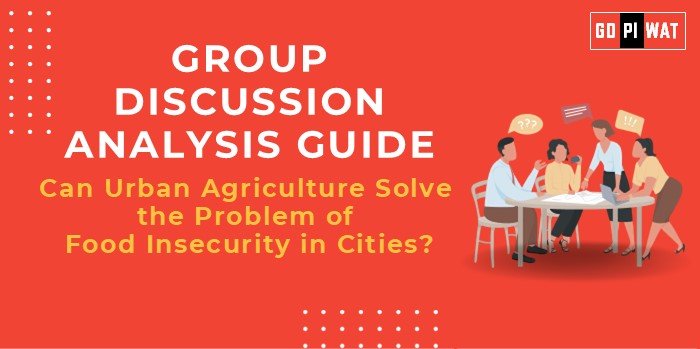📋 Group Discussion Analysis Guide: Can Urban Agriculture Solve the Problem of Food Insecurity in Cities?
🌐 Introduction to Urban Agriculture
- Opening Context: Urban agriculture, the practice of cultivating food in and around cities, has emerged as a potential solution to food insecurity in urban areas. As cities worldwide grapple with rising populations, limited space, and strained food supply chains, this topic gains relevance for B-school students, offering a lens to explore sustainability and innovation.
- Topic Background: Urban agriculture traces back to ancient civilizations like Mesopotamia but has gained renewed importance in the 21st century due to rapid urbanization. Today, initiatives like rooftop farming, community gardens, and hydroponics showcase its promise. However, whether these solutions can address large-scale food insecurity remains debatable.
📊 Quick Facts and Key Statistics
- 🏙️ Urban Population: 55% of the global population resides in cities, projected to reach 68% by 2050 (UN, 2023).
- ♻️ Food Waste: Cities contribute to 45% of global food waste, highlighting inefficiencies in urban food systems.
- 🌾 Urban Agriculture Impact: Rooftop farming in New York City produces over 120,000 pounds of food annually, benefiting 20,000 residents.
- 🍽️ Food Insecurity: 15% of urban households in developing countries face food insecurity (FAO, 2022).
🤝 Stakeholders and Their Roles
- Governments: Policy creation, funding, and zoning regulations for urban farming projects.
- Private Sector: Investment in sustainable technologies like hydroponics and vertical farming.
- Non-Governmental Organizations (NGOs): Community engagement and training in urban farming techniques.
- Citizens: Participation through backyard gardens, community projects, and local market support.
🏆 Achievements and Challenges
✨ Achievements
- 🌇 Efficient Use of Space: Vertical farming can yield 10 times more produce per square meter compared to traditional methods.
- 📦 Food Supply Chain Resilience: Localized production reduces dependency on long-distance transport.
- 👩🌾 Employment Creation: Urban farming creates jobs, especially for marginalized groups.
- 🌱 Environmental Benefits: Rooftop farms in urban areas help mitigate the urban heat island effect.
⚠️ Challenges
- 🔌 Resource Intensiveness: Hydroponics and vertical farming require significant energy inputs.
- 📊 Scale Limitations: Urban agriculture often struggles to meet the food demands of large populations.
- 📜 Policy Gaps: Inconsistent support and unclear regulations hinder adoption in many cities.
Global Comparisons: Singapore is a global leader in urban agriculture, producing 14% of its food locally despite space constraints, while Havana, Cuba, uses urban gardens to contribute 50% of the city’s fresh vegetables.
Case Studies: Delhi, India, promotes rooftop farming initiatives in areas like Dwarka, while Detroit, USA, revitalizes abandoned lots into community gardens providing fresh produce to low-income residents.
📖 Structured Arguments for Discussion
- ✅ Supporting Stance: “Urban agriculture promotes sustainability by reducing food miles and creating resilient food systems in cities.”
- ⚡ Opposing Stance: “Urban agriculture alone cannot meet the scale of urban food demand and may divert resources from traditional farming.”
- ⚖️ Balanced Perspective: “Urban agriculture is a complementary solution that requires integration with traditional methods and strong policy support to address urban food insecurity.”
💡 Effective Discussion Approaches
📣 Opening Approaches
- 📊 “With urban areas contributing to 70% of global food demand, localized solutions like urban agriculture are indispensable.”
- 🌍 “While urban farming offers innovative solutions, its energy requirements and scalability pose significant challenges.”
🛡️ Counter-Argument Handling
- 👍 Point: Urban farming requires high initial investments. Rebuttal: Long-term savings through reduced transport costs and waste management offset these expenses.
🛠️ Strategic Analysis of Strengths and Weaknesses
- Strengths: Space-efficient food production, mitigation of urban heat islands, community engagement.
- Weaknesses: High energy consumption, limited scalability, inconsistent policy frameworks.
- Opportunities: Integration with smart city projects, technological advancements in vertical farming.
- Threats: Urban land-use conflicts, dependence on energy-intensive technologies.
🔗 Connecting with B-School Applications
- Real-World Applications: Projects on sustainable business models for urban farming startups, case studies on food supply chain optimization.
- Sample Interview Questions:
- “How can urban farming be integrated into smart city planning?”
- “Evaluate the role of private investments in scaling urban agriculture.”
- Insights for B-School Students: Explore partnerships between governments and private sectors, and study innovations like aquaponics for sustainability projects.


